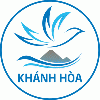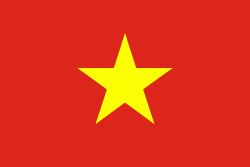Khánh Hòa Province (Tỉnh Khánh Hòa)
 |
The site of what is now Khánh Hòa had been within the territory of the Champa Kingdom before it was annexed to Đại Việt's (Vietnam's) territory. In 1653, one of the Nguyễn lords, Nguyễn Phúc Tần, sent his troops to occupy Phan Rang. The Champa king Bà Tấm surrendered to Nguyễn's troops and ceded an area from the east of the Phan Rang River to Phú Yên to the Nguyễn lord. The Nguyễn lord accepted the ceded territory and set up the Thái Khang garrison and divided it into two districts: Thái Khang and Diên Ninh.
In 1832, under the rule of Emperor Minh Mạng, this area was renamed Khánh Hòa and was divided into two districts, Phủ Diên Khánh and Phủ Ninh Hòa, which between them had a total of four counties: Phước Điền and Vĩnh Xương counties; and Quảng Phước and Tân Định counties, respectively.
Under French Indochina, the provincial capital was located in Diên Khánh Citadel, but it was relocated to Nha Trang in 1945.
During the Vietnam War, Khánh Hòa was a hub of military activity for the Republic of Vietnam army (ARVN), the Republic of Vietnam Navy, the Republic of Vietnam Air Force, and for the U.S. Pacific Air Forces (USAF), particularly in Cam Ranh Bay and at the Nha Trang Air Base. The II Corp. headquarters were located in Nha Trang and populated by general and field officers, intelligence groups and ARVN liaisons.
After the communists' victory and the Fall of Saigon on April 30, 1975, the communist regime merged two provinces, Phú Yên and Khánh Hòa, into Phú Khánh province on 29 October 1975. In 1977, Nha Trang was upgraded to city status. In 1982, the National Assembly decided to incorporate the Spratly Islands into Phú Khánh province. On June 30, 1989, the National Assembly reversed its previous decision and split Phú Khánh province into two provinces as they were before.
Map - Khánh Hòa Province (Tỉnh Khánh Hòa)
Map
Country - Vietnam
 |
 |
| Flag of Vietnam | |
Vietnam was inhabited by the Paleolithic age, with states established in the first millennium BC on the Red River Delta in modern-day northern Vietnam. The Han dynasty annexed Northern and Central Vietnam under Chinese rule from 111 BC, until the first dynasty emerged in 939. Successive monarchical dynasties absorbed Chinese influences through Confucianism and Buddhism, and expanded southward to the Mekong Delta, conquering Champa. The Nguyễn—the last imperial dynasty—surrendered to France in 1883. Following the August Revolution, the nationalist Viet Minh under the leadership of communist revolutionary Ho Chi Minh proclaimed independence from France in 1945.
Currency / Language
| ISO | Currency | Symbol | Significant figures |
|---|---|---|---|
| VND | Vietnamese đồng | ₫ | 0 |
| ISO | Language |
|---|---|
| KM | Central Khmer language |
| ZH | Chinese language |
| EN | English language |
| FR | French language |
| VI | Vietnamese language |















